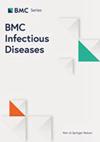寄生虫病健康知识量表的编制与评估
IF 3.4
3区 医学
Q2 INFECTIOUS DISEASES
引用次数: 0
摘要
寄生虫病在中国仍然是一个严重的公共卫生问题。以传播健康相关知识和促进健康行为为目的的健康教育在寄生虫病的预防和控制中发挥着至关重要的作用。本研究旨在开发一种工具来测量中国居民的寄生虫病健康素养。量表的开发基于定性和定量方法。定性方法包括焦点小组讨论和德尔菲咨询。问卷评估采用了多阶段抽样和试点研究的方法设计。量表的信度采用 Cronbach's α 和分半信度进行检验,其构建效度则采用确认性因子分析进行评估。量表的及格分数是通过接收者工作特征曲线确定的。在江苏省的六个县进行了横断面调查,并根据所在地随机抽取了参与调查的乡镇中 14-69 岁的居民。寄生虫病健康素养指标体系包括 3 个一级指标、9 个二级指标和 23 个三级指标。23 个项目的问卷具有良好的内部一致性(Cronbach's alpha = 0.774)和半信度(Spearman-Brown coefficient = 0.778)。问卷的及格分数为 60 分。从三个城市的参与者中共收集到 990 份有效问卷。对寄生虫病有健康知识了解的参与者占 15.8%。他们的得分受年龄、收入、就业和教育程度的影响。寄生虫病健康知识是一个综合指标,而不仅仅是知识或行为信息。知识和行为之间的相关性很弱。寄生虫病的健康行为能力与城市的地理位置和文化有关。对于被忽视的疾病,人们必须与医生积极讨论自己的行为。本文章由计算机程序翻译,如有差异,请以英文原文为准。
Development and evaluation of a health literacy scale for parasitic diseases
Parasitic diseases remain a serious public health problem in China. Health education aimed at disseminating health-related knowledge and promoting healthy behaviours, plays a crucial role in the prevention and control of parasitic diseases. This study aims to develop a tool to measure the parasitic disease health literacy of residents in China. Scale development was based on qualitative and quantitative methods. Qualitative method included focus group discussions and Delphi consultations. A methodological design with multistage sampling and a pilot study was used to evaluate the questionnaire. The scale’s reliability was tested using Cronbach’s α and split-half reliability, while its construct validity was assessed using confirmatory factor analysis. The scale’s passing score was determined using the receiver operating characteristic curve. A cross-sectional survey was conducted in six districts of the prefecture of Jiangsu and residents aged 14–69 years in the participating townships were randomly selected based on their location. The health literacy indicator system for parasitic diseases included 3 first-level, 9 s-level and 23 third-level indicators. The 23-item questionnaire demonstrated good internal consistency (Cronbach’s alpha = 0.774) and split-half reliability (Spearman-Brown coefficient = 0.778). The questionnaire’s passing score was 60. A total of 990 valid questionnaires were collected from participants in three cities. The percentage of participants with health literacy regarding parasitic diseases was 15.8%. Their scores were influenced by age, income, employment, and educational level. Health literacy of parasitic diseases is an integrated indicator rather than just knowledge or behavior information. The correlation between knowledge and behavior is weak. The capacity for healthy behavior of parasitic disease is associated with the location and culture of the city. For neglected diseases, it is important for people to talk positively about their behaviors with a doctor.
求助全文
通过发布文献求助,成功后即可免费获取论文全文。
去求助
来源期刊

BMC Infectious Diseases
医学-传染病学
CiteScore
6.50
自引率
0.00%
发文量
860
审稿时长
3.3 months
期刊介绍:
BMC Infectious Diseases is an open access, peer-reviewed journal that considers articles on all aspects of the prevention, diagnosis and management of infectious and sexually transmitted diseases in humans, as well as related molecular genetics, pathophysiology, and epidemiology.
 求助内容:
求助内容: 应助结果提醒方式:
应助结果提醒方式:


